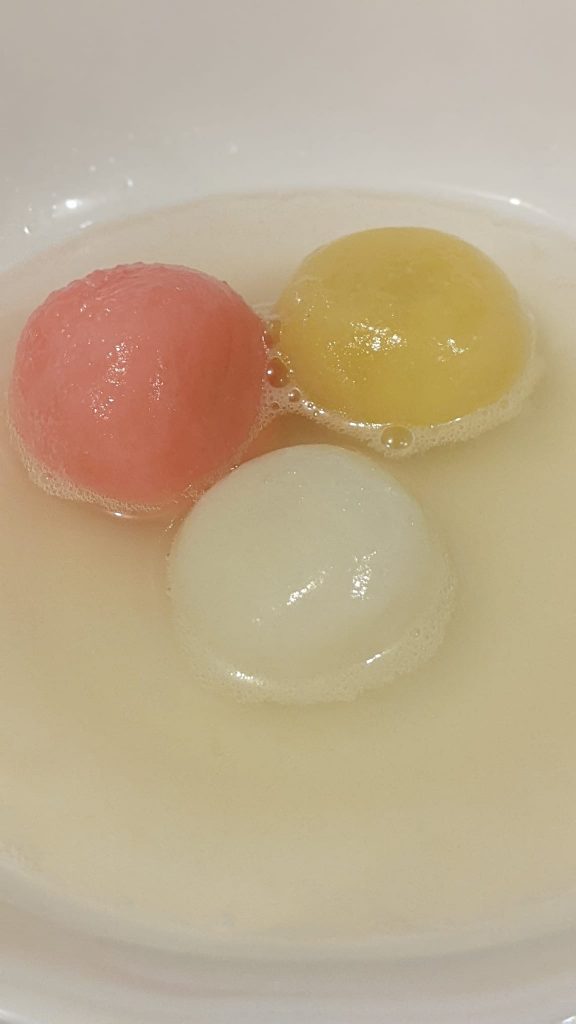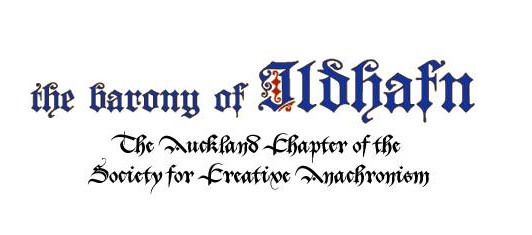Category
Muþa gehwylc mete þearf, mæl sceolon tidum gongan (Every mouth needs food; meals should come at the right time) Cook something
Entrant
Lihua Li
Entry
Shuituan 水團 (Also called ‘Tong Yuen’ 汤圆) from Benxin zhai shushi pu 本心齋蔬食譜 – circa 960-1127
History
There are many legends that surround the origins of these small, sweet, round dumplings. These are commonly associated with both Chinese/Lunar New Year as well as the Winter Solstice. The earliest mention however is that of the Han Dynasty origin story, where a young girl by the name of Yuan Xiao was taken from her home to serve the Emperor as a dumpling maker. She was very young to be serving the Emperor and the separation from her family caused her to fall into a deep depression. One of the Emperor’s advisors noticed her weeping by a well one day and promised to find a way to reunite her with her family. Yuan Xiao agreed to continue her service and the advisor, in the guise of a fortune teller proclaimed that the God of Fire was angry and would burn the city on the 15th day of Lunar New Year. The Emperor, keen to avoid this fate and the resulting panic from the foretelling asked for a solution. The ‘fortune teller’ proclaimed that they should appease the God of Fire by lighting red lanterns and firecrackers to make it appear as though the city were already burning. Everyone was also to make Tong Yuen (a specialty of Yuan Xiao’s) to be consumed during the festival. This meant that Yuan Xiao’s family would be asked to travel to the city for the festival to assist in the making of Tong Yuen and she would be able to reunite with them during their visit. Thus, tong yuen became both a symbol of unity and family.
There are some stylistic differences between the Northern and Southern style of Tong Yuen as Southern Tong Yuen are hand rolled glutinous rice dumplings with a sweet or savoury filling. Northern Tong Yuen however are made by repeatedly tossing a hard sweet (such as rock sugar) in water and glutinous rice flour. This creates a drier, chewier sweet than the Tong Yuen which we serve at Dumpling Feast.
Method
Traditionally, Tong Yuen would be filled with any number of fillings including peanuts, black sesame seeds, rock sugar or red bean paste. I begin by making the filling and dividing it into balls to be later encased by the dumpling dough.
For the peanut filling which I made for Dumpling Feast this year, I mixed equal parts peanut butter (crushed peanuts could also be used) and sugar. I then added a couple of tablespoons of corn starch to create a paste which was easier to work with. Ordinarily, I would omit the corn starch and freeze the peanut and sugar mixture overnight to create a workable mixture.
I then made the dumpling dough by mixing glutinous rice flour with warm water. It is important the water is warm as this facilitates proper hydration of the flour and allows it to become stretchy (but not overly sticky). I do not measure the amount of water to flour which I use as I add water a little bit at a time until I have a soft, malleable and non-sticky dough. I divide the dough into sections and keep each in a covered container until I am ready to work with it. This helps to prevent it from drying out.
Once everything is ready, I take a small lump of dough and roll it into a ball. I then gently press a ball of filling into the centre and smooth over the edges so there are no cracks in the dough. It is important that your finished ball is smooth as the filling can liquefy during cooking and escape if there are cracks in the balls.
To cook the dumplings, you first need to create a simple ginger syrup by mixing water, sugar and ginger in a pot and bringing to the boil. You can use either fresh ginger (peeled) or ginger powder. Once the water is at a rolling boil and the water has yellowed, you add the Tong Yuen and continue to boil (stir occasionally). Remove from the pot once the dumplings begin to float and serve either on their own or in a small bowl of syrup.
Challenges
In past years I have had difficulty getting the consistency of my dough correct as I have attempted to follow written recipes for the dough in order to provide measurements to people who wish to replicate these dumplings. However, following these recipes I have found my dough is often too dry or lacks the elasticity needed to be rolled into balls. I have also faced challenges with the water not being hot enough when I initially add the Tong Yuen, resulting in Tong Yuen that melt and dissolve in the water rather than cook into a chewy dumpling. This year, cooking by eye, feel and heart I faced none of these challenges and found the Tong Yuen worked well, although the addition of the corn starch did mean the dumpling fillings were less likely to liquefy while cooking.
The photo I have used for this entry is taken from Dumpling Feast 2023 as we neglected to photograph any of the food served during this year’s Dumpling Feast.
References
https://robbantoleno.com/blog/
https://www.scmp.com/magazines/post-magazine/food-drink/article/3208968/why-lunar-new-year-wouldnt-be-complete-without-glutinous-rice-balls-folklore-tangyuan-and-where-find

